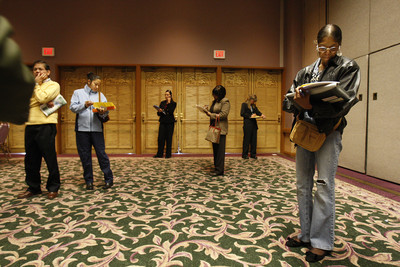State’s work force growing
The recession might have curbed population growth in Nevada, but new numbers show the Silver State's work force still grew at a brisk pace in the past year, and that might not be good news for the state's workers.
Clark County lost 10,000 residents between July 2007 and July 2008, officials say, yet the labor force in Las Vegas grew 4.5 percent year over year in January, from 972,100 to 1.02 million. Statewide, the labor base jumped 4 percent in the same period, from 1.35 million to 1.41 million.
Local economists say the local work force continues to grow for several reasons, and unabated expansion could mean steadily rising unemployment for some time to come and a bigger buyers' market for employers seeking workers.
Experts do not have concrete details on what's behind the surge in the state's labor base, but they guessed at a handful of demographic shifts that could be driving up the worker pool.
First, retirees probably have re-entered the work force as the value of assets including homes and 401(k)s has plummeted, said Jared McDonald, an economist with the state's Department of Employment, Training & Rehabilitation. And stay-at-home spouses are likelier to pound the pavement as their partners receive pink slips or see their office hours cut, he added.
Keith Schwer, executive director of the Center for Business and Economic Research at the University of Nevada, Las Vegas, counted both retirees and stay-at-home spouses in his tally of reasons the work force grew, and he threw in new graduates of local high schools and colleges as another contributor.
And Jeremy Aguero, a principal in local economic-research firm Applied Analysis, cited all of those groups plus the possibility of slight population growth.
Aguero said that local power utility NV Energy posted a 0.7 percent gain in the number of electric-meter hookups in January when compared with the same month a year earlier. That indicates that the city has more occupied homes than it had a year ago, which in turn hints at some population growth.
Thanks to those factors, the state's numbers, which researchers obtain through measuring unemployment claims and surveying households and businesses, show a surplus of job candidates flooding a soft hiring market and competing for comparatively fewer jobs.
Add in the rampant job loss that is also pushing up unemployment figures, and Nevada probably will see a sustained increase in joblessness, economists say.
As unemployment rises, salaries could fall, and employers could enjoy an even better buyers' market if they want to upgrade or round out their work forces. The possible result: changes in how companies weigh the status of their staffs, Aguero said.
"Employers may not be thinking about expanding, but the new consideration is whether they have the right group of employees," Aguero said. "With such a large pool of workers available, and with the potential for downward pressure on wages, employers could be forced into the question of whether one employee is the right employee, or whether they could hire someone with a better skill set at a lower cost."
Schwer said he thinks most companies will stick with the staffs they have assembled. Unless a worker seriously underperforms, the expense of turnover and training could cost more than a business would save in lower pay.
"Companies want people who show up for work, and they want people who know their business," Schwer said. "They're not going to just lay people off in order to get somebody else because there's a lot of economic benefit to having people working for you who know your company or who are trained."
Not counted in either unemployment statistics or work force numbers are discouraged workers: people who quit job-hunting altogether because they have searched for months to no avail.
Researchers track figures on discouraged workers only at the national level, so the state's department of employment does not have details on how many Nevadans have quit the work force. But McDonald said it's likely that increasing numbers of Nevadans have halted their job searches, though a growing labor force would seem to counter the idea that more people have opted out of the job market.
Economists say the numbers don't always match; a work force can expand even as the ranks of the discouraged rise.
Nationally, unemployment in February was 8.1 percent, with a 0.4 percent rate of discouraged workers on top of that jobless figure. McDonald said Nevada, which reported 9.4 percent unemployment in January, probably has a discouraged-worker rate similar to the national average, though he wouldn't count out a slightly higher statewide percentage.
"We seem to be getting hit especially hard by this recession," he said.
Contact reporter Jennifer Robison at jrobison@reviewjournal.com or 702-380-4512.


















